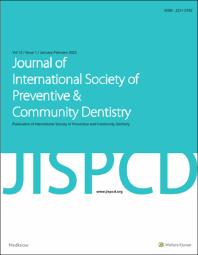Mostrar el registro sencillo del ítem
Impact of Puppet Theater on Oral Health Knowledge and Oral Hygiene in Preschoolers from a Peruvian Educational Institution: A Quasi-experimental Study
| dc.contributor.author | Ladera-Castañeda1, Marysela2 | |
| dc.contributor.author | Córdova-Limaylla1, Nancy Edith | |
| dc.contributor.author | Briceño-Vergel1, Gissela | |
| dc.contributor.author | Rosas-Díaz1, José Carlos | |
| dc.contributor.author | Cervantes-Ganoza2, Luis Adolfo3 | |
| dc.contributor.author | Cayo-Rojas1, César Félix | |
| dc.date.accessioned | 2022-02-01T05:05:36Z | |
| dc.date.available | 2022-02-01T05:05:36Z | |
| dc.date.issued | 2022-01-01 | |
| dc.identifier.uri | https://hdl.handle.net/20.500.14308/3474 | |
| dc.description.abstract | Aim: The puppet theater, due to its artistic and educational characteristics, could allow children to develop oral health self-care in an attractive and fun way. The aim of this study was to evaluate the impact of puppet theater on oral health knowledge and oral hygiene in preschoolers from a Peruvian public school. Materials and Methods: An analytical, longitudinal, and quasi-experimental study was conducted in 132 preschoolers divided into three age-matched groups (3, 4, and 5 years old) from August to November 2019 in a Peruvian public school. At 4 weeks and 4 months after performing the puppet theater, a validated questionnaire of five closed questions was used to evaluate oral health knowledge, and the Greene–Vermillion index [only bacterial plaque index (BPI) part] was used to evaluate oral hygiene, considering good (0–0.6), fair (0.7–1.8), and poor (1.9–3.0). The theater sessions were held every week for the first month and every 2 weeks for the following 3 months. To analyze the levels in the BPI, the Wilcoxon and Friedman test was used to compare related measures, and to compare the knowledge for each question of the questionnaire, the McNemar and Cochran’s Q tests were used, considering a P-value less than 0.05. Results: The BPI in relation to age (3, 4, and 5 years), before and after 4 months of performing the puppet theater, was 1.9 [confidence interval (CI): 1.7–2.0], 1.8 (CI: 1.6–1.9), and 1.8 (CI: 1.7–2.0), decreasing to 0.9 (CI: 0.8–1.0), 0.8 (CI: 0.7– 0.9), and 0.9 (CI: 0.8–1.00), respectively. In relation to gender (men and women), it was 1.8 (CI: 1.7–2.0) and 1.8 (CI: 1.7–1.9), decreasing to 0.9 (CI: 0.8–1.0) and 0.8 (CI: 0.8–0.9), respectively. In relation to origin (urban or rural), it was 1.8 (CI: 1.7–1.9) and 1.8 (CI: 1.4–2.2), decreasing to 0.9 (CI: 0.8–0.9) and 0.8 (CI: 0.7–0.9), respectively. The level of BPI and oral health knowledge improved significantly (P < 0.001) over time in all preschoolers, except in those who came from the rural area (P > 0.05). Conclusion: The application of the puppet theater positively influenced the preschoolers in such a way that it significantly improved their oral health knowledge and oral hygiene at 4 weeks and 4 months, in both genders of 3, 4, and 5 years of age, and in those whose origin was the urban area. However, no significant improvements in oral health knowledge and oral hygiene were observed in those preschoolers whose origin was the rural area. | es_PE |
| dc.format | application/pdf | es_PE |
| dc.language.iso | Eng | es_PE |
| dc.publisher | Journal of International Society of Preventive & Community Dentistry | es_PE |
| dc.rights | info:eu-repo/semantics/openAccess | es_PE |
| dc.rights | Attribution-NonCommercial-NoDerivs 3.0 United States | * |
| dc.rights.uri | licenses/by-nc-nd/3.0/us/ | es_PE |
| dc.rights.uri | http://creativecommons.org/licenses/by-nc-nd/3.0/us/ | * |
| dc.source | Universidad Privada San Juan Bautista | es_PE |
| dc.source | Repositorio Institucional UPSJB | es_PE |
| dc.subject | improvements in oral health knowledge | es_PE |
| dc.subject | and oral hygiene were observed | es_PE |
| dc.subject | in those preschoolers whose origin | es_PE |
| dc.title | Impact of Puppet Theater on Oral Health Knowledge and Oral Hygiene in Preschoolers from a Peruvian Educational Institution: A Quasi-experimental Study | es_PE |
| dc.type | info:eu-repo/semantics/article | es_PE |
| dc.subject.ocde | http://purl.org/pe-repo/ocde/ford#5.01.01 | es_PE |
| dc.publisher.country | PE | es_PE |
| dc.date.embargoEnd | 2022-01-31 | |
| dc.type.version | info:eu-repo/semantics/publishedVersion | es_PE |


